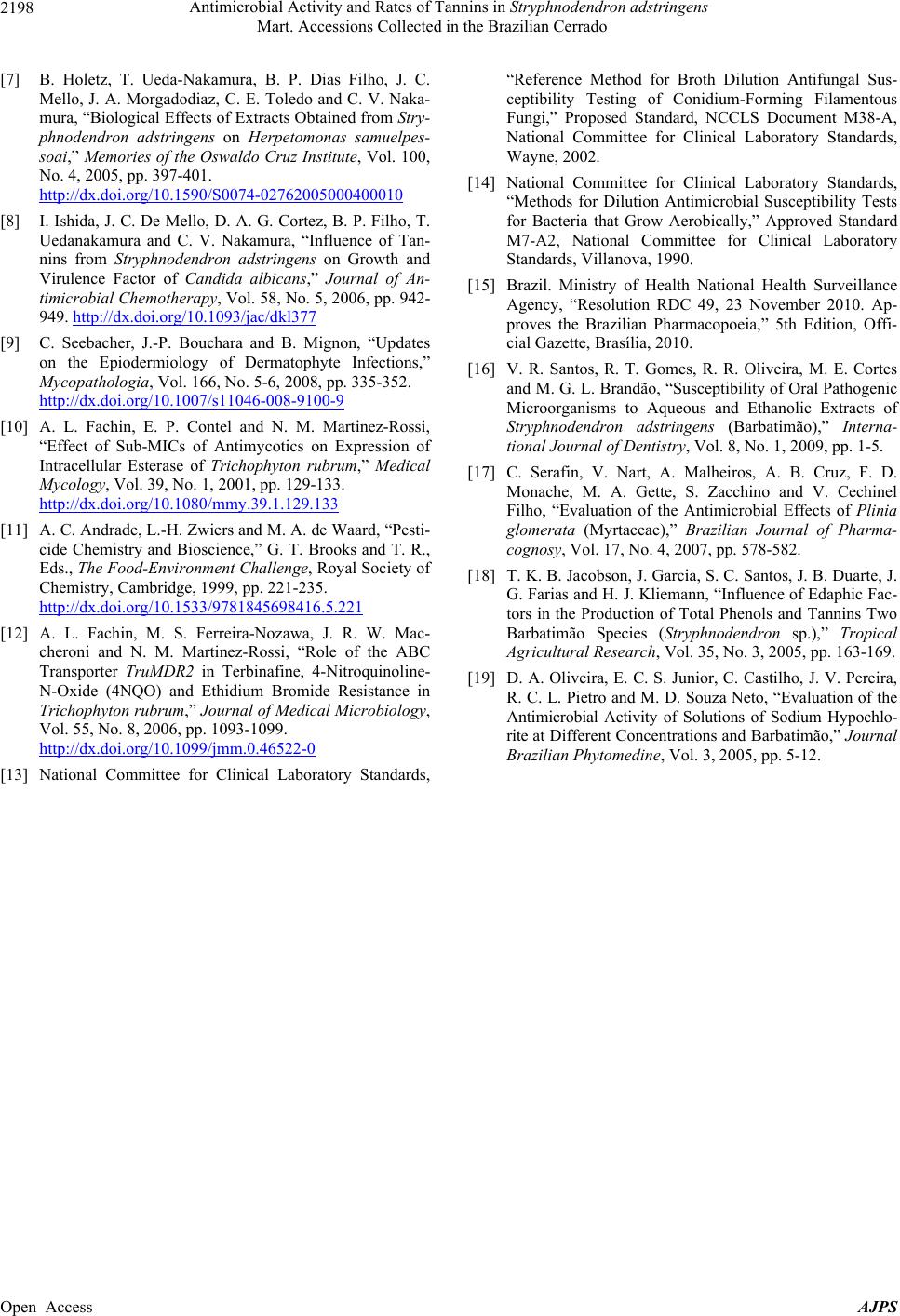
Antimicrobial Activity and Rates of Tannins in Stryphnodendron adstringens
Mart. Accessions Collected in the Brazilian Cerrado
2198
[7] B. Holetz, T. Ueda-Nakamura, B. P. Dias Filho, J. C.
Mello, J. A. Morgadodiaz, C. E. Toledo and C. V. Naka-
mura, “Biological Effects of Extracts Obtained from Stry-
phnodendron adstringens on Herpetomonas samuelpes-
soai,” Memories of the Oswaldo Cruz Institute, Vol. 100,
No. 4, 2005, pp. 397-401.
http://dx.doi.org/10.1590/S0074-02762005000400010
[8] I. Ishida, J. C. De Mello, D. A. G. Cortez, B. P. Filho, T.
Uedanakamura and C. V. Nakamura, “Influence of Tan-
nins from Stryphnodendron adstringens on Growth and
Virulence Factor of Candida albicans,” Journal of An-
timicrobial Chemotherapy, Vol. 58, No. 5, 2006, pp. 942-
949. http://dx.doi.org/10.1093/jac/dkl377
[9] C. Seebacher, J.-P. Bouchara and B. Mignon, “Updates
on the Epiodermiology of Dermatophyte Infections,”
Mycopathologia, Vol. 166, No. 5-6, 2008, pp. 335-352.
http://dx.doi.org/10.1007/s11046-008-9100-9
[10] A. L. Fachin, E. P. Contel and N. M. Martinez-Rossi,
“Effect of Sub-MICs of Antimycotics on Expression of
Intracellular Esterase of Trichophyton rubrum,” Medical
Mycology, Vol. 39, No. 1, 2001, pp. 129-133.
http://dx.doi.org/10.1080/mmy.39.1.129.133
[11] A. C. Andrade, L.-H. Zwiers and M. A. de Waard, “Pesti-
cide Chemistry and Bioscience,” G. T. Brooks and T. R.,
Eds., The Food-Environment Challenge, Royal Society of
Chemistry, Cambridge, 1999, pp. 221-235.
http://dx.doi.org/10.1533/9781845698416.5.221
[12] A. L. Fachin, M. S. Ferreira-Nozawa, J. R. W. Mac-
cheroni and N. M. Martinez-Rossi, “Role of the ABC
Transporter TruMDR2 in Terbinafine, 4-Nitroquinoline-
N-Oxide (4NQO) and Ethidium Bromide Resistance in
Trichophyton rubrum,” Journal of Medical Microbiology,
Vol. 55, No. 8, 2006, pp. 1093-1099.
http://dx.doi.org/10.1099/jmm.0.46522-0
[13] National Committee for Clinical Laboratory Standards,
“Reference Method for Broth Dilution Antifungal Sus-
ceptibility Testing of Conidium-Forming Filamentous
Fungi,” Proposed Standard, NCCLS Document M38-A,
National Committee for Clinical Laboratory Standards,
Wayne, 2002.
[14] National Committee for Clinical Laboratory Standards,
“Methods for Dilution Antimicrobial Susceptibility Tests
for Bacteria that Grow Aerobically,” Approved Standard
M7-A2, National Committee for Clinical Laboratory
Standards, Villanova, 1990.
[15] Brazil. Ministry of Health National Health Surveillance
Agency, “Resolution RDC 49, 23 November 2010. Ap-
proves the Brazilian Pharmacopoeia,” 5th Edition, Offi-
cial Gazette, Brasília, 2010.
[16] V. R. Santos, R. T. Gomes, R. R. Oliveira, M. E. Cortes
and M. G. L. Brandão, “Susceptibility of Oral Pathogenic
Microorganisms to Aqueous and Ethanolic Extracts of
Stryphnodendron adstringens (Barbatimão),” Interna-
tional Journal of Dentistry, Vol. 8, No. 1, 2009, pp. 1-5.
[17] C. Serafin, V. Nart, A. Malheiros, A. B. Cruz, F. D.
Monache, M. A. Gette, S. Zacchino and V. Cechinel
Filho, “Evaluation of the Antimicrobial Effects of Plinia
glomerata (Myrtaceae),” Brazilian Journal of Pharma-
cognosy, Vol. 17, No. 4, 2007, pp. 578-582.
[18] T. K. B. Jacobson, J. Garcia, S. C. Santos, J. B. Duarte, J.
G. Farias and H. J. Kliemann, “Influence of Edaphic Fac-
tors in the Production of Total Phenols and Tannins Two
Barbatimão Species (Stryphnodendron sp.),” Tropical
Agricultural Research, Vol. 35, No. 3, 2005, pp. 163-169.
[19] D. A. Oliveira, E. C. S. Junior, C. Castilho, J. V. Pereira,
R. C. L. Pietro and M. D. Souza Neto, “Evaluation of the
Antimicrobial Activity of Solutions of Sodium Hypochlo-
rite at Different Concentrations and Barbatimão,” Journal
Brazilian Phytomedine, Vol. 3, 2005, pp. 5-12.
Open Access AJPS